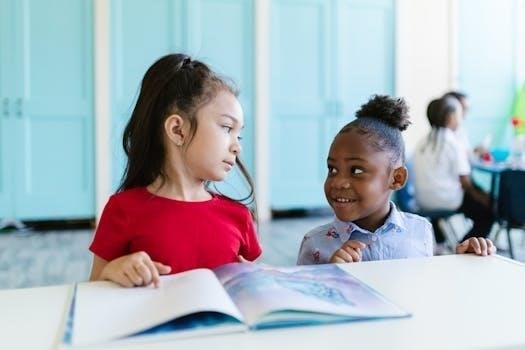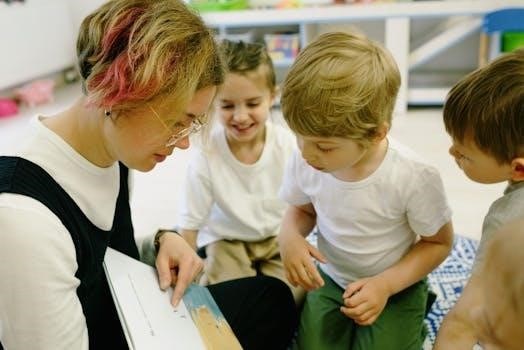kindergarten reading books pdf

Kindergarten Reading Books PDF⁚ A Comprehensive Guide
Welcome to your comprehensive guide! This resource is designed to help parents and educators find the best kindergarten reading books in PDF format. We’ll explore book lists, selection tips, and resources to make reading fun and educational. Discover how to support early literacy skills effectively with engaging PDF materials.
Kindergarten reading is a crucial step in a child’s educational journey, laying the foundation for future academic success. It’s more than just recognizing letters and words; it’s about fostering a lifelong love for reading and learning. Introducing children to books at this early age helps them develop essential literacy skills, expand their vocabulary, and improve their comprehension abilities.
The use of PDF reading materials in kindergarten offers a convenient and accessible way to engage young learners. PDFs can be easily distributed, viewed on various devices, and often include interactive elements that enhance the reading experience. These digital resources complement traditional books, providing a diverse range of options for educators and parents;
A well-chosen selection of kindergarten reading books, whether in print or PDF format, can ignite a child’s imagination and curiosity. Stories that are age-appropriate, engaging, and aligned with learning objectives can make reading an enjoyable and rewarding activity. By incorporating a variety of books into the kindergarten curriculum, educators can cater to different learning styles and interests, ensuring that every child has the opportunity to thrive as a reader.
Benefits of Reading in Kindergarten
Reading in kindergarten offers a multitude of benefits that extend far beyond basic literacy. It’s a cornerstone for cognitive development, fostering critical thinking, and enhancing a child’s ability to understand and interpret information. Early exposure to reading stimulates the brain, promoting neural connections that are essential for learning and problem-solving.
Reading also significantly expands a child’s vocabulary. As they encounter new words in books, they learn their meanings and how to use them in context. This not only improves their communication skills but also boosts their confidence in expressing themselves. A rich vocabulary is a powerful tool that supports academic achievement and personal growth.
Furthermore, reading cultivates empathy and emotional intelligence. Through stories, children can explore different perspectives, understand diverse emotions, and develop a sense of compassion. They learn to connect with characters and their experiences, which helps them build social skills and navigate complex social situations. Reading is a window to the world, allowing children to explore different cultures, ideas, and ways of life, broadening their horizons and fostering a lifelong love of learning.
Key Skills Developed Through Reading
Reading in kindergarten is fundamental to developing a range of essential skills that set the stage for future academic success. One of the primary skills cultivated is phonemic awareness, which involves recognizing and manipulating the individual sounds in words. This skill is crucial for decoding words and developing fluency.

Reading also significantly enhances comprehension skills; Children learn to understand the meaning of what they read, make inferences, and draw conclusions. They develop the ability to follow a story’s plot, identify characters, and understand the relationships between events. These comprehension skills are vital for academic success across all subjects.
Additionally, reading fosters vocabulary development. As children encounter new words in books, they learn their meanings and how to use them in context. A strong vocabulary is essential for both reading and writing, enabling children to express themselves effectively and understand complex ideas. Furthermore, reading promotes critical thinking skills, encouraging children to analyze information, evaluate arguments, and form their own opinions. These skills are essential for problem-solving and decision-making in all aspects of life.
Selecting Appropriate Reading Books for Kindergarten
Choosing the right reading books for kindergarteners is crucial for fostering a love of reading and supporting their literacy development. When selecting books, it’s important to consider several factors to ensure they are age-appropriate and engaging. One of the primary considerations is the reading level of the book. Kindergarteners are typically beginning readers, so books should have simple, repetitive text with clear and easy-to-decode words.
Look for books that focus on basic sight words and CVC (consonant-vowel-consonant) words, as these are fundamental for early reading success. The content of the book should also be engaging and relevant to kindergarteners’ interests. Topics such as animals, family, friends, and everyday activities are often popular choices.
Additionally, consider the book’s illustrations. High-quality, colorful illustrations can capture children’s attention and help them understand the story. Illustrations should complement the text and provide visual cues to aid comprehension. Books that promote discussion, thought, imagination, and creative art can be particularly valuable.
Finally, think about the book’s length. Kindergarteners have short attention spans, so shorter books are generally more effective. Aim for books that can be read in one sitting to maintain their interest and engagement. By carefully considering these factors, you can select reading books that are both enjoyable and beneficial for kindergarteners.
Factors to Consider When Choosing Books
When choosing reading books for kindergarteners, several key factors should be taken into account to ensure the selections are both appropriate and beneficial for their reading development. First and foremost, consider the readability of the text. Kindergarten books should feature simple sentences, repetitive patterns, and a limited number of sight words to help build confidence and fluency. Books with CVC (consonant-vowel-consonant) words are also ideal for this age group.
Engagement is another critical factor. Books should be captivating and relevant to a kindergartener’s interests, such as animals, family, or everyday experiences. The illustrations play a vital role here, as they should be colorful, clear, and supportive of the story’s narrative. High-quality visuals can significantly enhance comprehension and maintain a child’s interest.
The length of the book is also important. Kindergarteners typically have short attention spans, so shorter books that can be read in one sitting are preferable. Furthermore, consider the book’s themes and messages. Books that promote positive values, social-emotional learning (SEL) skills, and cultural diversity can be incredibly beneficial.
Lastly, think about the book’s format. Whether it’s a physical book or a PDF, ensure it’s easy to handle and visually appealing. PDFs should be well-formatted and easy to navigate, especially if children will be using them independently. By considering these factors, you can select books that are both educational and enjoyable for kindergarteners.
Recommended Kindergarten Reading Book Lists
Creating a curated reading list for kindergarteners is essential for fostering a love of reading and building foundational literacy skills. One excellent starting point is a list that includes both classic and modern titles, ensuring a diverse range of reading experiences. Consider incorporating books that focus on sight words, phonics, and early comprehension skills.

For classic options, titles like “Are You My Mother?” by P.D. Eastman and “The Three Little Pigs” are timeless choices that engage young readers with simple narratives and memorable characters. Modern selections, such as the “Pete the Cat” series, offer fun, relatable stories with catchy refrains that children adore.
Another recommended list could be organized by reading level, allowing educators and parents to select books appropriate for each child’s individual progress. This approach can include beginner-level books with repetitive text and basic vocabulary, gradually advancing to more complex stories with longer sentences and varied themes.
Don’t forget to include books that promote social-emotional learning. Stories that address emotions, friendships, and problem-solving can help children develop crucial life skills while enhancing their reading comprehension. Resources like the Free Library of Philadelphia offer lists specifically curated to support these skills.
Finally, consider including a mix of fiction and non-fiction books to expose children to a wide range of topics and genres. This variety can spark curiosity and encourage a lifelong love of learning.
Classic Books for Kindergarten
Classic books for kindergarten represent a timeless collection of stories that have captivated young readers for generations. These books often feature simple narratives, memorable characters, and valuable life lessons, making them ideal for introducing children to the joy of reading. They help develop a strong foundation in literacy and comprehension.
One quintessential classic is “The Very Hungry Caterpillar” by Eric Carle. Its vibrant illustrations and repetitive text make it engaging and easy for young children to follow. Another popular choice is “Brown Bear, Brown Bear, What Do You See?” by Bill Martin Jr. and Eric Carle, which uses rhythmic language and colorful animals to teach colors and patterns.
“Make Way for Ducklings” by Robert McCloskey is another cherished classic that tells the heartwarming story of a family of ducks navigating the bustling streets of Boston. This book not only entertains but also teaches children about problem-solving and perseverance.
Additionally, stories like “Corduroy” by Don Freeman offer gentle lessons about friendship and self-acceptance. These books have stood the test of time because they resonate with children on an emotional level and provide positive messages.
Integrating these classic books into a kindergarten reading program ensures that children are exposed to stories that foster imagination, build vocabulary, and promote a lifelong love of reading. These books serve as a cornerstone for early literacy development.
Modern Books for Kindergarten
Modern books for kindergarten offer fresh perspectives and innovative storytelling techniques that resonate with today’s young readers. These books often tackle contemporary themes, feature diverse characters, and incorporate engaging visuals that capture children’s attention. They complement classic literature by introducing new styles and ideas.
“I am a Tornado” by Drew Beckmeyer is a modern tale that uses empathy to explore themes of anger and understanding. This book provides a unique way to discuss emotions with young children. Similarly, books that showcase characters from various backgrounds help children develop a broader understanding of the world.
Many modern books also focus on social-emotional learning (SEL) skills, addressing topics such as kindness, resilience, and self-awareness. These stories help children navigate their feelings and build positive relationships. Interactive books, such as those that encourage participation or include lift-the-flaps, are also popular choices.
Additionally, modern kindergarten books often embrace humor and playfulness, making reading an enjoyable experience. Authors may use silly characters or unexpected plot twists to keep children engaged and entertained. The integration of technology, such as QR codes linking to interactive content, is another trend in modern children’s literature.
By incorporating modern books into a kindergarten reading curriculum, educators can ensure that children are exposed to a diverse range of stories that reflect the world around them. These books provide valuable opportunities for discussion and exploration, fostering a love of reading that extends beyond the classroom.

Free Printable Kindergarten Reading Booklets (PDFs)
Free printable kindergarten reading booklets in PDF format are a fantastic resource for educators and parents looking to support early literacy at home or in the classroom. These booklets offer a cost-effective and convenient way to provide engaging reading materials tailored to young learners. They often focus on foundational skills such as phonics, sight words, and comprehension.

One example is a reading booklet centered around a beach theme, like “Jan can dig,” which includes CVC words and common sight words, making it ideal for reinforcing basic reading skills. These booklets often incorporate coloring activities, adding an element of fun and creativity. Children can engage with the story while also practicing fine motor skills.
Editable PDF options are also available, allowing teachers to customize the booklets with each student’s name, the letter of the week, or specific sight words. This personalization can enhance engagement and make the learning experience more relevant. Furthermore, free printable booklets often include a variety of themes and topics, catering to different interests and learning styles.
By using these resources, educators can supplement their existing curriculum with targeted practice materials. Parents can also use these booklets to support their child’s reading development outside of school. With easy access and customizable options, free printable kindergarten reading booklets in PDF format are a valuable tool for fostering a love of reading in young children.
Where to Find Free Reading Resources
Finding free reading resources for kindergarteners is easier than ever, thanks to the wealth of online platforms and community initiatives dedicated to promoting early literacy. Libraries are a cornerstone of free reading materials, offering not only physical books but also digital resources, including e-books and audiobooks, accessible through their websites. The Free Library of Philadelphia, for example, provides free access to a vast collection of children’s books and resources, including Storytime Sidekicks to enhance reading sessions.
Websites specializing in educational resources, such as Education.com, offer a comprehensive library of free worksheets, games, and lesson plans that support reading development. These resources cover a range of skills, from phonics and sight words to reading comprehension. Many publishers and authors also provide free printable materials and activities on their websites to engage young readers.
Open educational resource (OER) repositories offer a treasure trove of free educational materials, including reading resources for kindergarten. These repositories often feature openly licensed textbooks, lesson plans, and activities created by educators and shared for public use. Additionally, numerous websites compile lists of free reading resources, guiding parents and teachers to valuable content.
Community organizations and non-profits dedicated to literacy often provide free reading programs, workshops, and resources for young children. By exploring these various avenues, parents and educators can access a wide array of free reading materials to support kindergarteners’ literacy journey.
Using PDFs Effectively in Kindergarten Reading Programs
Integrating PDFs into kindergarten reading programs can be a cost-effective and versatile way to enhance learning. PDFs offer access to a wide range of reading materials, from printable booklets to interactive activities, making them an invaluable resource for educators and parents. To maximize their effectiveness, it’s essential to select PDFs that align with kindergarten learning objectives and cater to diverse learning styles.
One key advantage of PDFs is their adaptability. Teachers can easily customize PDFs using tools like Adobe Reader to include specific sight words, names, or themes relevant to their students. Editable PDFs allow for personalized learning experiences, such as creating name-writing practice sheets or tailored reading booklets. These resources can be used for individual practice, group activities, or take-home assignments.
When using PDFs, consider the format and presentation. Opt for visually appealing designs with clear fonts and engaging illustrations to capture children’s attention. Incorporate interactive elements, such as fill-in-the-blanks, coloring pages, or matching games, to reinforce learning concepts. Regularly assess students’ progress and adjust the selection of PDFs to meet their evolving needs;
Ensure that parents have access to the same PDFs used in the classroom to support reading practice at home. By thoughtfully integrating PDFs into the curriculum, educators can create a dynamic and effective kindergarten reading program that fosters literacy skills and cultivates a love for reading.
Tips for Engaging Children with Reading PDFs
Engaging young children with reading PDFs requires a creative and interactive approach. Start by selecting PDFs with vibrant illustrations and relatable characters to capture their attention. Use expressive voices and animated gestures while reading aloud to bring the stories to life. Encourage children to participate by asking questions about the characters, plot, and setting.
Incorporate hands-on activities to complement the reading experience. For example, after reading a PDF about animals, have children draw their favorite animal or act out its movements. Use printable worksheets from the PDFs for coloring, tracing, or matching exercises to reinforce key concepts. Break up reading sessions with short movement breaks or songs to keep children energized and focused.
Create a cozy and inviting reading environment by setting up a designated reading corner with comfortable seating, soft lighting, and a variety of books. Allow children to choose the PDFs they want to read, fostering a sense of ownership and excitement. Celebrate their reading achievements with stickers, certificates, or small rewards to motivate them to continue learning.
Make reading a social activity by inviting friends or family members to join in. Read PDFs together as a group and discuss the stories afterward. Utilize editable PDFs to create personalized reading materials with children’s names and interests. By implementing these strategies, you can transform reading PDFs into engaging and enjoyable experiences for kindergarteners.




